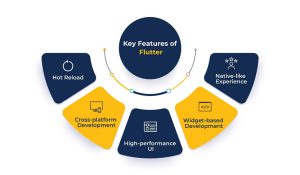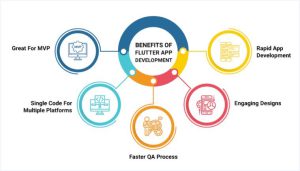In the rapidly evolving world of mobile app development, having a framework that allows you to create high-quality applications for multiple platforms simultaneously is invaluable. Flutter, an open-source UI software development toolkit created by Google, has emerged as a powerful solution for building natively compiled applications for mobile, web, and desktop from a single codebase. In this comprehensive guide, we will delve into the world of Flutter, exploring its foundations, key features, advantages, and real-world applications.
 Understanding Flutter
Understanding Flutter
Flutter was introduced by Google in 2017 with the aim of simplifying the development of cross-platform applications. It is designed to provide a consistent and expressive framework for developers to build user interfaces across various platforms. Here are some of the core components and concepts that define Flutter:
- Dart Programming Language: Flutter uses the Dart programming language as its primary language. Dart is known for its simplicity, speed, and strong support for object-oriented programming. Developers familiar with languages like Java or JavaScript will find Dart relatively easy to pick up.
- Widget-Based Architecture: In Flutter, everything is a widget. Widgets are the building blocks of the user interface, ranging from basic elements like buttons and text to complex layouts. The widget-based architecture enables developers to create highly customizable and reusable UI components.
- Hot Reload: One of Flutter’s standout features is “hot reload.” This allows developers to instantly see the effects of code changes without restarting the entire application. It significantly speeds up the development process and facilitates experimentation.
- Rich Set of Widgets: Flutter provides an extensive library of widgets for creating visually appealing and interactive user interfaces. These widgets are designed to mimic the native look and feel of the target platform, ensuring a consistent user experience.
- Single Codebase: Perhaps the most significant advantage of Flutter is the ability to write one codebase that runs on multiple platforms, including iOS, Android, web, and desktop. This eliminates the need for separate development teams and reduces development time and costs.
 Advantages of Flutter
Advantages of Flutter
- Cross-Platform Development: Flutter’s single codebase approach simplifies the process of creating apps for multiple platforms. This not only saves time but also ensures feature parity across platforms.
- Highly Customizable UI: With Flutter, developers have granular control over the user interface. The widget-based architecture allows for the creation of unique and visually appealing designs.
- Excellent Performance: Flutter apps are known for their impressive performance. The framework compiles Dart code to native ARM code, resulting in near-native performance on both iOS and Android.
- Fast Development: Hot reload and a rich set of pre-built widgets make development in Flutter swift and efficient. Developers can iterate quickly and see changes instantly.
- Strong Community and Ecosystem: Flutter has a thriving community and a growing ecosystem of packages and plugins that extend its functionality. This means developers have access to a wide range of resources and tools.
Real-World Applications
Flutter’s versatility and ease of use have made it a popular choice for a variety of applications across different industries:
- Mobile Apps: Flutter is widely used for building mobile apps, including e-commerce apps, social networking platforms, and productivity tools. Examples include Alibaba, Google Ads, and Reflectly.
- Web Applications: Flutter enables developers to create web applications with a native look and feel. Companies like BMW and WeChat are using Flutter for their web interfaces.
- Desktop Applications: Flutter has expanded its capabilities to desktop platforms, allowing developers to build applications for Windows, macOS, and Linux. This opens up new possibilities for cross-platform desktop software.
- Embedded Systems: Flutter can be used to create interfaces for embedded systems and IoT devices. It’s a powerful tool for developing applications that require both a mobile and web interface.
- Game Development: While not a game engine, Flutter can be used to create mobile games with rich, interactive UIs. Game developers appreciate its performance and flexibility.
Getting Started with Flutter
If you’re eager to begin your journey with Flutter, here are some steps to kickstart your exploration:
- Install Flutter: Start by installing Flutter and Dart on your development machine. The official Flutter website provides comprehensive installation instructions for various platforms.
- Learn Dart: Familiarize yourself with the Dart programming language, as it’s the foundation of Flutter development. Dart’s official website offers a wealth of resources for learning the language.
- Explore Flutter Documentation: The Flutter documentation is a goldmine of information for beginners and experienced developers alike. It covers everything from getting started to advanced topics.
- Use Flutter Create: Flutter Create is a tool that generates a new Flutter project with sample code. It’s an excellent way to experiment and learn by doing.
- Join the Flutter Community: Connect with other Flutter enthusiasts and developers through forums, social media, and online communities. The Flutter community is known for its support and knowledge sharing.
Conclusion
Flutter has brought a revolution to cross-platform app development, offering a powerful and efficient framework for building applications that run seamlessly on mobile, web, and desktop platforms. Its simplicity, performance, and extensive widget library have made it a top choice for developers and organizations looking to maximize their reach while minimizing development efforts.
Whether you’re a seasoned developer looking to expand your skill set or a newcomer eager to dive into the world of app development, Flutter provides an exciting and accessible entry point. With Flutter, you can turn your app ideas into reality, reaching a wider audience and delivering outstanding user experiences across various platforms. So, embark on your Flutter journey with confidence and creativity, and watch your app ideas come to life.

